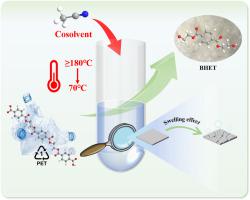Polymer Degradation and Stability ( IF 6.3 ) Pub Date : 2022-12-29 , DOI: 10.1016/j.polymdegradstab.2022.110245
Junjie Huang , Dongxia Yan , Qingqing Zhu , Xiujie Cheng , Jing Tang , Xingmei Lu , Jiayu Xin

|
The depolymerization of polyethylene terephthalate (PET) can proceed by using ethylene glycol (EG) as an alcoholysis solvent. However, high reaction temperature (≥180℃) of glycolysis process requires high energy consumption, and unfortunately results in yellowing of monomer product, i.e., bis(2-hydroxyethyl) terephthalate (BHET), limiting the production of high-quality and colorless recycled PET (rPET). To address this problem, a strategy involving acetonitrile as cosolvent was applied to decrease glycolysis temperature to 90℃ or even lower, and solvents as well as catalyst can be recycled and reused. The glycolysis of PET is hard to proceed at 90℃. However, the swelling effect of acetonitrile caused cracks and defects on the surface of PET, which promoted the depolymerization of PET and led to an S-shaped reaction curve. Besides, adding acetonitrile could significantly accelerate the degradation of oligomers into BHET. Under the optimal reaction conditions, the conversion of PET and yield of BHET could reach 96% and 90%, respectively.
中文翻译:

聚对苯二甲酸乙二醇酯在较温和条件下的解聚
聚对苯二甲酸乙二醇酯(PET)的解聚可以通过使用乙二醇(EG)作为醇解溶剂来进行。但糖酵解过程反应温度高(≥180℃),能耗高,且单体产物对苯二甲酸二(2-羟乙基)酯(BHET)发黄,限制了优质无色回收物的生产宠物(再生宠物)。为了解决这个问题,采用乙腈作为助溶剂的策略将糖酵解温度降低至90℃甚至更低,并且溶剂和催化剂可以回收再利用。PET的糖酵解在90℃时难以进行。但乙腈的溶胀作用使PET表面产生裂纹和缺陷,促进PET的解聚,导致反应曲线呈S形。除了,添加乙腈可以显着加速低聚物降解为BHET。在最佳反应条件下,PET转化率和BHET收率分别达到96%和90%。































 京公网安备 11010802027423号
京公网安备 11010802027423号